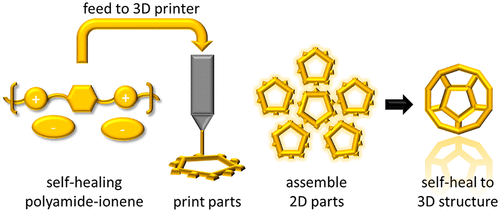当前位置:
X-MOL 学术
›
ACS Appl. Polym. Mater.
›
论文详情
Our official English website, www.x-mol.net, welcomes your feedback! (Note: you will need to create a separate account there.)
Nearly Perfect 3D Structures Obtained by Assembly of Printed Parts of Polyamide Ionene Self-Healing Elastomer
ACS Applied Polymer Materials ( IF 5 ) Pub Date : 2020-09-25 , DOI: 10.1021/acsapm.0c00799 Kathryn O’Harra 1 , Naroa Sadaba 2 , Mikel Irigoyen 2 , Fernando Ruipérez 2 , R. Aguirresarobe 2 , Haritz Sardon 2 , Jason Bara 1
ACS Applied Polymer Materials ( IF 5 ) Pub Date : 2020-09-25 , DOI: 10.1021/acsapm.0c00799 Kathryn O’Harra 1 , Naroa Sadaba 2 , Mikel Irigoyen 2 , Fernando Ruipérez 2 , R. Aguirresarobe 2 , Haritz Sardon 2 , Jason Bara 1
Affiliation

|
Herein, we demonstrate 3D printing of an elastomeric imidazolium polyamide-ionene which exhibits intrinsic shape-memory (SM) and self-healing (SH) character, reporting optimized printing conditions and rheological properties. This study shows the suitability of this material for 3D-printing via fused deposition modeling. The 3D-printed objects retain elasticity and SM when external force is applied, and the elastomeric character is quantified via mechanical testing. This work highlights the benefits of SH behavior as a design feature combatting inherent material weaknesses or insufficient adhesion at seams and layer junctions. DFT calculations confirmed the importance of ionic interactions and H-bonding in the SH process.
中文翻译:

通过组装聚酰胺离子自修复弹性体的印刷零件获得的近乎完美的3D结构
在本文中,我们演示了弹性咪唑聚酰胺-紫罗烯的3D打印,该3D打印具有固有的形状记忆(SM)和自愈(SH)特性,报告了优化的印刷条件和流变性能。这项研究表明该材料适合通过熔融沉积建模进行3D打印。当施加外力时,3D打印的对象保留弹性和SM,并且通过机械测试对弹性特征进行量化。这项工作强调了SH行为的好处,因为它具有克服固有的材料弱点或接缝和层连接处粘合力不足的设计特征。DFT计算证实了SH过程中离子相互作用和氢键的重要性。
更新日期:2020-11-13
中文翻译:

通过组装聚酰胺离子自修复弹性体的印刷零件获得的近乎完美的3D结构
在本文中,我们演示了弹性咪唑聚酰胺-紫罗烯的3D打印,该3D打印具有固有的形状记忆(SM)和自愈(SH)特性,报告了优化的印刷条件和流变性能。这项研究表明该材料适合通过熔融沉积建模进行3D打印。当施加外力时,3D打印的对象保留弹性和SM,并且通过机械测试对弹性特征进行量化。这项工作强调了SH行为的好处,因为它具有克服固有的材料弱点或接缝和层连接处粘合力不足的设计特征。DFT计算证实了SH过程中离子相互作用和氢键的重要性。


























 京公网安备 11010802027423号
京公网安备 11010802027423号